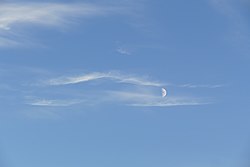Sky


The sky is the appearance of the atmosphere around the surface of the planet from our point of view. We see many objects that are actually in space such as the Sun, the Moon, and stars because they are in the sky. On a clear day the sky appears blue.
Physics
At night, it appears from very dark blue to black. The deepness of the blue increases as we look toward the horizon, and up to the point above us. The sky, which is made up of gas molecules, is blue because of the random scattering of sunlight by the molecules.
Rayleigh scattering
Rayleigh scattering defines the amount of scattering of light rays. Blue light scatters much more than red, which is why the sky appears blue on a clear day. Depending on the time of day, the sky may appear different colors. At sunrise or sunset, the sky may appear red, orange and other colors depending on how low the sun is and how close it is to night. [1]
Many objects can be seen in the sky. There are objects from space like the Sun, Moon, planets and stars. There are also many weather events seen in the sky. For example, these can be fog, clouds, rain or lightning. Weather is caused by different patterns and temperatures in the atmosphere. Other things that can be seen in the sky are birds, other flying animals,[clarification needed] and aircraft.
Solar System
Other planets have skies too. Because the types of gases in their atmospheres are different, they have different sky colors. For example, the sky on Mars is pink.[2]
Sky Media
The night sky over Slovenia in July
Cirriform clouds and a quarter Moon in the blue daytime sky over Germany
Earth's atmosphere scatters a greater proportion of blue light than of red light.
The crescent Moon remains visible just moments before sunrise.
Dawn is the beginning of morning twilight.
The Milky Way can be seen as a large band across the night sky, and is distorted into an arch in this 360° panorama.
Related pages
Other websites
- Day Sky Images Archived 2007-08-15 at the Wayback Machine
- Night Sky Images Archived 2019-01-19 at the Wayback Machine
- Sky Photo Gallery Archived 2007-04-30 at the Wayback Machine
- Why is the sky blue?
References
- ↑
- Tyndall, John (December 1868). "On the Blue Colour of the Sky, the Polarization of Skylight, and on the Polarization of Light by Cloudy Matter Generally". Proceedings of the Royal Society. 17: 223–33. Bibcode:1868RSPS...17..223T. doi:10.1098/rspl.1868.0033. JSTOR 112380. S2CID 121593427.
- Lord Rayleigh (June 1871). "On the scattering of light by small particles". Philosophical Magazine. 41 (275): 447–51.
- Watson, J. G. (June 2002). "Visibility: Science and Regulation". J. Air & Waste Manage. Assoc. 52 (6): 628–713. Bibcode:2002JAWMA..52..628W. doi:10.1080/10473289.2002.10470813. PMID 12074426. S2CID 1078961.
- Gibbs, Philip (May 1997). "Why is the sky Blue?". Usenet Physics FAQ. Archived from the original on 2 November 2015. Retrieved 11 December 2012.
- ↑ "Mars Mobile". marsmobile.jpl.nasa.gov. Archived from the original on 2019-04-18. Retrieved 2019-01-04.









